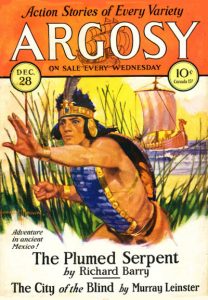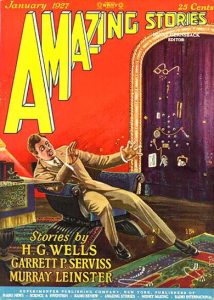 Although magazines have been around since the seventeenth century, it wasn’t until the last month of 1896 that the pulp magazine was born. It was left to Frank A. Munsey – a man about whom it has been suggested, “contributed to the journalism of his day the talent of a meat packer, the morals of a money changer and the manner of an undertaker” – to deliver the first American periodical specifically intended for the common man — THE ARGOSY. In his own words, Munsey decided to create “a magazine of the people and for the people, with pictures and art and good cheer and human interest throughout.”
Although magazines have been around since the seventeenth century, it wasn’t until the last month of 1896 that the pulp magazine was born. It was left to Frank A. Munsey – a man about whom it has been suggested, “contributed to the journalism of his day the talent of a meat packer, the morals of a money changer and the manner of an undertaker” – to deliver the first American periodical specifically intended for the common man — THE ARGOSY. In his own words, Munsey decided to create “a magazine of the people and for the people, with pictures and art and good cheer and human interest throughout.”
That same year, on June 16, a child was born who would become one of THE ARGOSY’s regular writers for nearly four decades — William Fitzgerald Jenkins. Best known and remembered under his pseudonym of Murray Leinster, Jenkins wrote and published more than 1,500 short stories and articles, fourteen movie scripts, and hundreds of radio scripts and television plays. Active as a writer for nearly seven decades, Jenkins’ writing career began in early 1916 when his work began to be featured in H. L. Mencken’s and George Jean Nathan’s THE SMART SET.
Although he wrote in a wide range of genres — western, detective, jungle adventure, horror, spicy, and even love — Jenkins is best known for his science fiction. His first story in the field, “The Runaway Skyscraper,” published in February 22, 1919 issue of ARGOSY AND RAILROAD MAN’S MAGAZINE, is considered a science fiction classic. Other greats, including “The Mad Planet” (ARGOSY for June 12, 1920) and “The Red Dust” (ARGOSY ALL-STORY WEEKLY, April 2, 1921) soon followed.
An extremely adaptable writer, Jenkins/Leinster published some remarkably inventive stories during the late twenties and early 1930s including “The Darkness on Fifth Avenue” (ARGOSY ALL-STORY WEEKLY, November 30, 1929), “The City of the Blind” (ARGOSY, December 12, 1928), “Sidewise in Time” (ASTOUNDING STORIES, June 1934) — which introduced the concept of parallel worlds — and “Proxima Centuri” (ASTOUNDING STORIES, March 1935). He would reach his prime as a science fiction writer during the decade following the Second World War. During this period, Jenkins/Leinster penned such classics as “First Contact” (ASTOUNDING SCIENCE FICTION, May 1945 and probably his most highly regarded story), “A Logic Named Joe” (ASTOUNDING SCIENCE FICTION, March 1946) — which anticipated computers and the Internet — and “Exploration Team” (ASTOUNDING SCIENCE FICTION, March 1956) — which won the 1956 Hugo Award for Best Novelette.
Remaining active in the field until about 1970, Will Jenkins/Murray Leinster died on June 8, 1975. A longtime craftsman in the field of magazine fiction writing, Leinster is fondly remembered as “The Dean of Science Fiction.” He would be 120 years old on this very day.
(Although the fiction of Will Jenkins/Murray Leinster appeared in a wide range of magazines — ARGOSY — including the December 12, 1928 issue with cover art by Howard V. Brown — BLACK BAT DETECTIVE MYSTERIES, BLACK MASK, BLUE BOOK, BREEZY STORIES, COLLIER’S, COWBOY STORIES, DANGER TRAILS, DETECTIVE FICTION WEEKLY, DETECTIVE STORY MAGAZINE, ESQUIRE, FRONTIER STORIES, JUNGLE STORIES, LOVE STORY MAGAZINE, MYSTERY STORIES, RANCH ROMANCES, THE SATURDAY EVENING POST, SHORT STORIES, THE SMART SET, SNAPPY STORIES, THE THRILL BOOK, THRILLING DETECTIVE, TRIPLE-X WESTERN, WEIRD TALES, and WEST — he is primarily remembered for his science fiction. In that genre, he published in an equally wide range of titles, including the first continuing science fiction magazine, AMAZING STORIES.
 The early issues of Hugo Gernsback’s magazine featured a great deal of material reprinted from other sources. Works by Jules Verne, H. G. Wells, Edgar Allan Poe, and others were regularly featured in the early numbers of the magazine. Another author featured regularly was Murray Leinster. “The Runaway Skyscraper” was reprinted in the third issue, dated June 1926, while “The Mad Planet” found its way into the eighth issue, dated November 1926. Leinster’s name was featured on the cover to the January 1927 number with cover art by Frank R. Paul. “The Red Dust” appeared inside.
The early issues of Hugo Gernsback’s magazine featured a great deal of material reprinted from other sources. Works by Jules Verne, H. G. Wells, Edgar Allan Poe, and others were regularly featured in the early numbers of the magazine. Another author featured regularly was Murray Leinster. “The Runaway Skyscraper” was reprinted in the third issue, dated June 1926, while “The Mad Planet” found its way into the eighth issue, dated November 1926. Leinster’s name was featured on the cover to the January 1927 number with cover art by Frank R. Paul. “The Red Dust” appeared inside.
PulpFest 2016 will salute both ARGOSY — the first pulp fiction magazine — and AMAZING STORIES — the first continuing science fiction magazine — at this year’s convention. Please join us in the Columbus, Ohio Arena district at the Hyatt Regency hotel and the city’s spacious convention center from July 21 through July 24 for “Summer’s AMAZING Pulp Con!”
Please remember that the Hyatt Regency Columbus is sold out of rooms for July 21 through July 23. At www.columbusconventions.com/thearea.php, you’ll find a list of area hotels courtesy of the Greater Columbus Convention Center. Alternately, you can search for a room at tripadvisor or a similar website to find a hotel near the convention. Thanks so much to everyone who has reserved a room at our host hotel. By staying at the Hyatt Regency, you’ve helped to ensure the convention’s success.)






